What Is Teriyaki Sauce And How To Use It
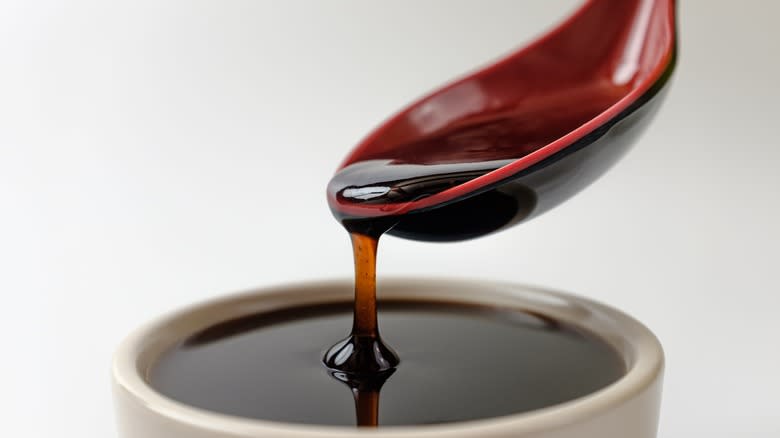
The history of teriyaki sauce is as complex as its flavor. Most will associate the name with Japanese tradition, and though they would be partially correct, this sauce has a much more complicated origin that tells a story of migration and the fusion of different culinary practices. During centuries-long travels, the sauce continually evolved as it was modeled and tweaked with regional influences. Today, it does not seem to belong to a specific location but signifies an internationally adopted sauce that promises to deliver Asian-inspired flavors.
As you go deeper into the story, you'll realize why teriyaki sauce became a global sensation. We took a closer look to provide you with deeper insight into the variations and style differences, along with its health aspects and ways to implement more teriyaki sauce into your cooking. This umami-rich hero deserves more of a spotlight, not only because of its fascinating history but also because it has the inherent ability to turn any bland dish into a spectacular feast of flavors.
Read more: 12 Little-Known Facts About Salt
Teriyaki Refers To A Japanese Cooking Method
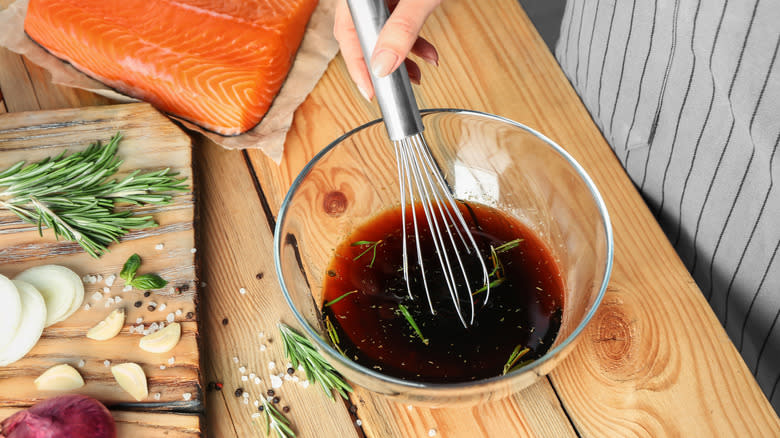
Nowadays, teriyaki is usually associated with the sauce, but the word was first used to label a cooking technique. The word teriyaki is a portmanteau of the Japanese word "teri," which can be roughly translated as shiny or glowy, and the word "yaki," a collective term for dishes that are usually grilled or broiled. The name was originally coined to refer to all the dishes that come off the grill or broiler with a glossy coating.
That distinctive shine is mainly attained by mixing soy sauce, sake, and mirin into a sauce to brush over the ingredients on the grill. Originally, the method was reserved for fish. Besides acting as a flavor booster, the sauce also protected and preserved the fish, which was essential before the invention of modern appliances.
The teriyaki technique is estimated to date back to the 17th-century Edo period in Japan, but the first official reference was in the 19th century. The Meiji period that followed Edo brought significant changes to Japanese society that led to major modernization and prosperity. The Japanese diet started to include different proteins -- namely beef and chicken -- and the teriyaki technique that was once reserved for fish was applied to meat. The recipe was slightly modified and gained its current form, mainly combining soy sauce with sake, mirin, and sugar.
The Condiment Eventually Became Popular In The US
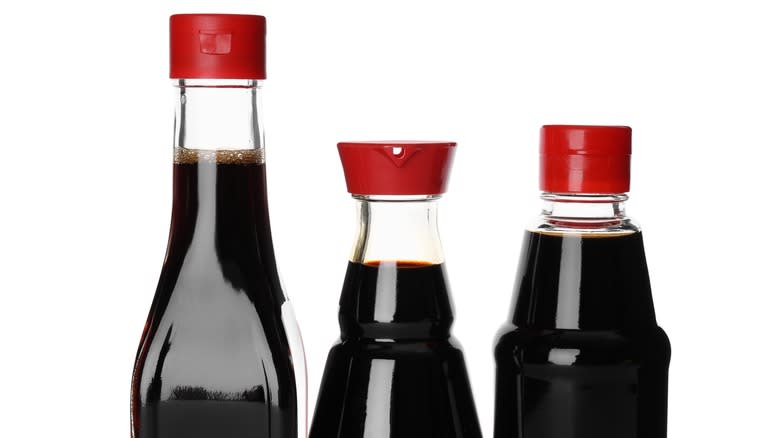
Though teriyaki is of Japanese descent, teriyaki sauce as a concept was first introduced on American soil. It's believed that Japanese immigrants who settled in Hawaii were the first to whip up a sweetened soy sauce concoction to mimic the one used in Japan. Whereas the original concept spoke about the technique, in the U.S., teriyaki became interchangeable with the sauce, which is how it is mainly known today.
The Japanese version was straightforward and based on three or four ingredients, but American-born teriyaki was tweaked with various components to give it a new character. It is usually more intense in flavor, with a thick and viscous texture. The Japanese sauce originally used for the teriyaki technique is much lighter and brighter in flavor, and generally has a thinner texture.
Teriyaki got a new look in the States and it moved away from its image of being an easy homemade sauce to whip up with available ingredients. In the U.S., it soon became a bottled sauce found on supermarket shelves. Since then, it has gone global, and we now mostly know it as a pre-mixed, bottled version.
There Is No Uniform Recipe For Teriyaki Sauce
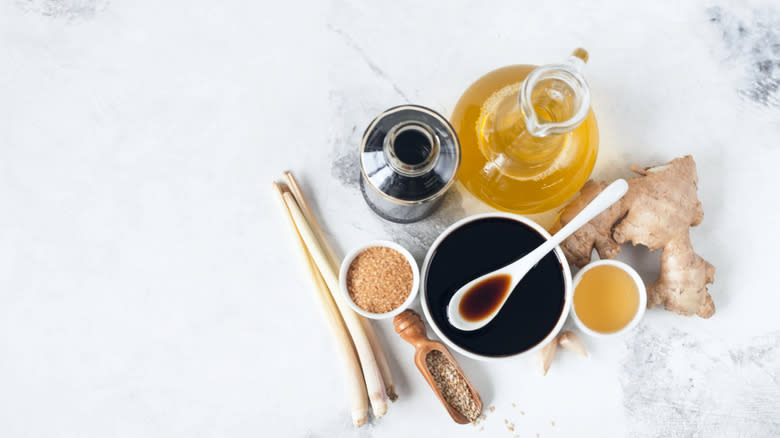
Considering teriyaki sauce has such a deep and complex history, it's challenging to provide a recipe that can be called traditional or authentic or one that encompasses its variations. Japanese-style teriyaki is a simple affair, and the combination usually includes soy sauce, sake, sugar, and mirin (Japanese rice wine traditionally used in cooking). The classic technique calls for combining all ingredients into a pot and then simmering. The sauce thickens as it cooks, attaining a subtle caramelized note from the sugar and rice wine, with a well-balanced and complex character that remains light on the palate.
The first versions of the American-style sauce often used pineapple juice and brown sugar, giving it a different flavor profile. When the sauce was bottled, it included cornstarch, resulting in a product that was more intense and thicker than the original. This style became more prevalent in the West, and it's what most people expect from store-bought versions. Nowadays, the sauce is commonly tweaked with numerous ingredients. Ginger and garlic have become almost a staple, but you'll also see recipes boosted with sesame oil, rice vinegar, and chili peppers.
The Sauce Is Packed With Umami
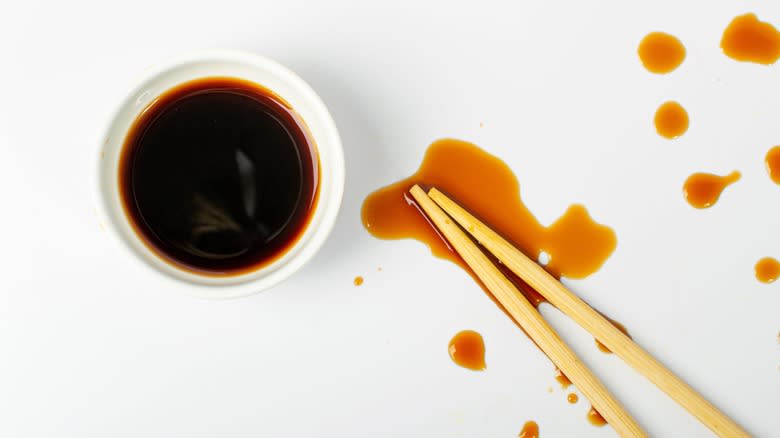
Umami is often labeled as the fifth taste, but it is the most mysterious and difficult to explain or put into context. At its core, umami is not like any other taste, but it is also a combination of them all. It's often associated with ingredients that possess an incredible depth of flavor that cannot be classified as bitter, sweet, sour, or salty. Some ingredients that capture the distinctive quality are mushrooms, seaweed, and miso paste, and complex sauces also fall into the category. Along with fish sauce, you will regularly see soy sauce topping the list of most potent umami ingredients.
Besides soy sauce, teriyaki does not incorporate other umami-rich components, but since the base is packed with this specific taste, it naturally translates into the final product. Teriyaki delivers a kaleidoscope of sweet, salty, and caramelized flavors, but it also brings that unexplainable oomph to every dish due to the abundance of umami. If you decide to whip up homemade teriyaki, you can amp up the umami content by adding seaweed or mushrooms as you cook it down.
Japanese Teriyaki Chicken Is Slightly Different
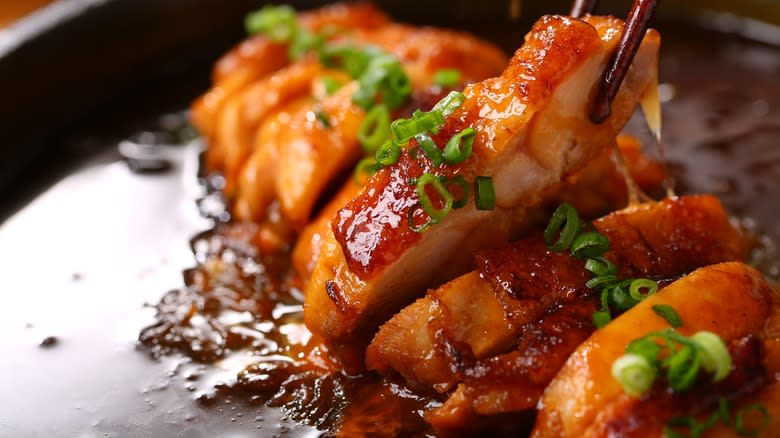
Teriyaki chicken is perhaps the best internationally known teriyaki-laden dish. In the unlikely event that you never heard about it, this classic consists of tender pieces of chicken doused in a glossy teriyaki glaze usually served over plain rice. The dish is a mall foodcourt staple in the U.S. and is believed to have first appeared on American soil before being introduced to Japan. This theory may sound reasonable as the dish is way more prominent stateside, but chicken teriyaki can be found in Japan with its variations.
While Westernized chicken teriyaki can be made with chicken breasts, Japanese versions almost always use deboned chicken thighs, which are left whole or roughly chopped into larger chunks. Traditionally, the pieces are always skillfully sliced before serving. In Japan, it is also quite common to leave the skin on, which eventually turns into a crispy, teriyaki-coated delight.
Of course, the difference is also evident in the sauce. In Japan, you won't find it in the store, but rather, the simple combination of four classic ingredients is more subdued and nuanced. Outside Japan, bottled teriyaki is a go-to option, but even homemade versions tend to incorporate a myriad of ingredients -- such as ginger, garlic, pineapple juice, cornstarch, or citrus juice -- resulting in a bold and gaudy sauce with a thick consistency.
Teriyaki Burger Is A Japanese Invention
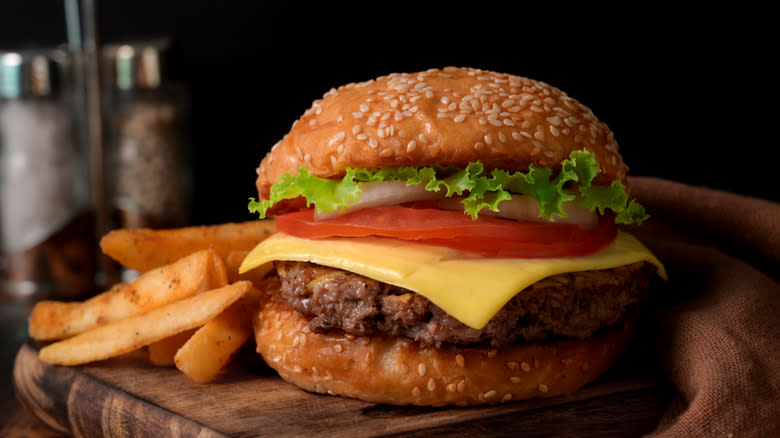
The foundations of a teriyaki burger are like a classic burger, with the bun and beef patty as the main components. You will usually see it stuffed with lettuce and tomato, while mayonnaise seems to be the preferred condiment. The teriyaki twist appears on the patty, which is generously basted in the sauce while on the grill. It might sound like an eccentric American fusion recipe, but this burger actually has its roots in Japan.
Unlike chicken teriyaki, which has a pretty murky background and undisclosed history, the origin of the teriyaki burger is well recorded. It made its debut in 1973 and was first released by Mos Burger, a Japanese fast-food company that tried to mimic American burger joints. As the story goes, the locals were not initially interested in the novel creation. However, when the word spread among high school students, the burger soon became trendy, inspiring other eateries to adopt the concept.
Teriyaki burgers are still a common sight on Japanese menus. Even Japanese McDonald's carries the burger, but it is one of the items you can't get in the U.S. Of course, Mos Burger never gave up on this all-star. This iconic dish is still featured on the menu in its original form and is considered one of the most interesting fusions in modern Japanese cuisine.
Seattle Is Known For A Unique Teriyaki Style
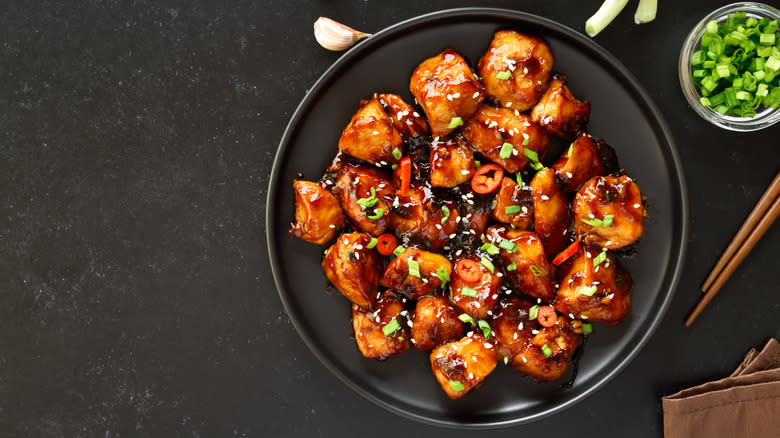
Although teriyaki sauce gained momentum in Hawaii, it attained a completely new look in Seattle, a city that will become labeled as the home of the most over-the-top teriyaki recipe. The teriyaki boom that started in the 1960s was warmly welcomed in Seattle. As the story goes, in 1976, Japanese-born Toshihiro Kasahara opened the first specialized teriyaki joint in Seattle. The restaurant was a humble affair, featuring a compact menu, generous portions, and low prices. Despite the unassuming nature, it was a hit among the locals.
What followed suit was a total domination of teriyaki restaurants. Many of these were led by Korean immigrants, who deemed the original version of the sauce too plain. Replicating Korean tradition, they added garlic and ginger and heavily used white sugar and pineapple juice borrowed from Hawaiian practices. Peanut butter and cornstarch were also referenced as ingredients, and the final result was a sauce that no longer resembled the stripped-down Japanese version. The end product was a gloriously sticky and potently sweet sauce that became Seattle's signature dish, earning a special mention in the teriyaki canon.
There Are Few Suitable Substitutes For Teriyaki
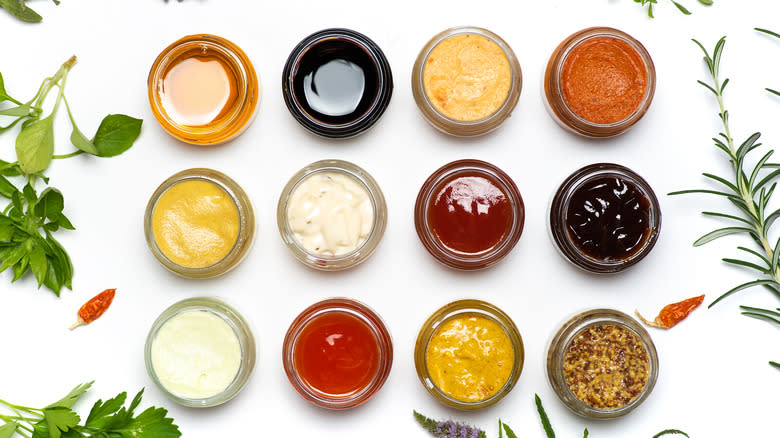
In an ideal situation, you would always have teriyaki sauce on hand for an impromptu dinner that requires less than 20 minutes of prep, or at least keep a stock of the ingredients to blend into a flavor-packed homemade version. But we all know that nothing is ideal, and if you are missing some items or just looking for a decent teriyaki replacement, a couple of options could deliver similar results.
You can always turn to soy sauce and mix it with a sweetener. Though the sauce will not have the same balance without the other ingredients, it will still provide salty flavors and a touch of umami. Ponzu sauce is another good option. This classic Japanese sauce is also built on soy sauce and mirin but gets a sharp, tangy note from yuzu and vinegar. Ponzu will not reach a caramelized sweetness but it still holds plenty of complexity and brightness.
Hoisin sauce could also be a suitable replacement since the base is made with fermented soybean paste, so you'll get plenty of umami depth. Korean bulgogi sauce is the perfect replacement for those who prefer thick and gooey teriyaki sauces. Bulgogi sometimes includes a subtle spicy kick, which can be a good option for stir-fries that call for something extra to pierce through the sweetness.
Teriyaki Sauce Is Not Bad For You, But Use It Sparingly
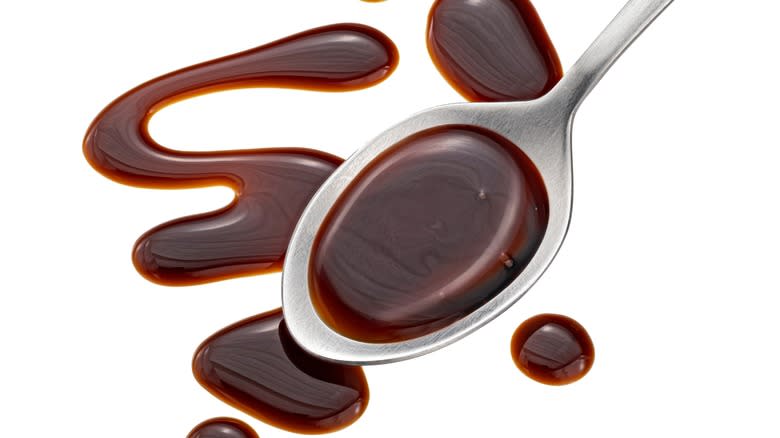
Health-wise, teriyaki sauce is generally considered one of the better options in the condiment section. It is relatively low in calories, with between 15 and 35 calories per tablespoon depending on the brand. Teriyaki has no added fat, which makes it fat-free and suitable for people who need to avoid fatty mayo or cream-based sauces.
However, the sugar and sodium contents slightly diminish the nutritional structure. Soy sauce, as one of the main constituents, is a sodium-laden ingredient. One tablespoon of teriyaki sauce has over 600 mg of sodium, roughly a quarter of the daily intake recommended by the U.S. Food & Drug Administration. So, if you're watching your salt intake, this may not be the best option. Sugar could also be a problem if you're adding a lot of sauce to dishes. If you're looking for a condiment that will contribute to your daily intake of proteins, vitamins, and minerals, teriyaki sauce is not the right choice.
As with everything else, moderation is key. Saying that teriyaki sauce is bad for your health would be unfounded without taking medical history, dietary habits, and serving sizes into account. The secret lies in a well-balanced diet, and if you are sticking to the recommended servings and keeping your nutritional goals in check, teriyaki can be a great flavor booster in the kitchen.
Don't Reserve Teriyaki Only For Glazes
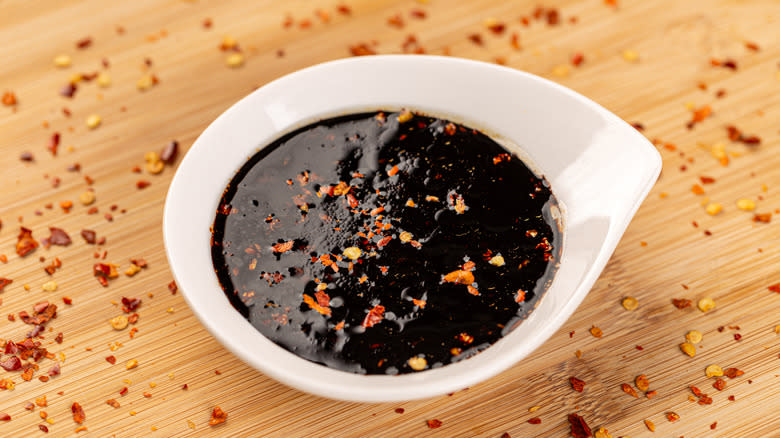
Teriyaki is commonly used as a marinade, but it is best known for its spectacular glazing properties, which give any ingredient a glossy, caramelized finish. Ideally, you should use it when pan-frying, roasting, or grilling. The sauce can be applied at any stage or re-applied throughout the cooking process, though it's crucial to baste the surface toward the end to achieve that shiny glaze.
But if you like the qualities teriyaki brings to the table, you don't have to limit its use strictly to glazing. Though not traditional, teriyaki can work as an excellent dipping sauce. It is easily tweaked with spices and works great for dumplings, veggies, and egg rolls. Similarly, you can turn the sauce into a dressing that can be drizzled on top of salads or grain bowls. Though teriyaki is not that common in stir-fried dishes, it is a suitable seasoning that is best added at the end. Since it is quite intense, adjust the amount so you don't overwhelm the other elements.
Though entirely unconventional, teriyaki can be added as seasoning to bring out bolder flavors and deliver umami to your culinary creations. It's a great addition to ground meat, especially burger patties. Proteins can also benefit from an additional coating during the last few minutes of grilling for the ultimate teriyaki experience.
Teriyaki Goes Well With Fish, Meat, And Veggies
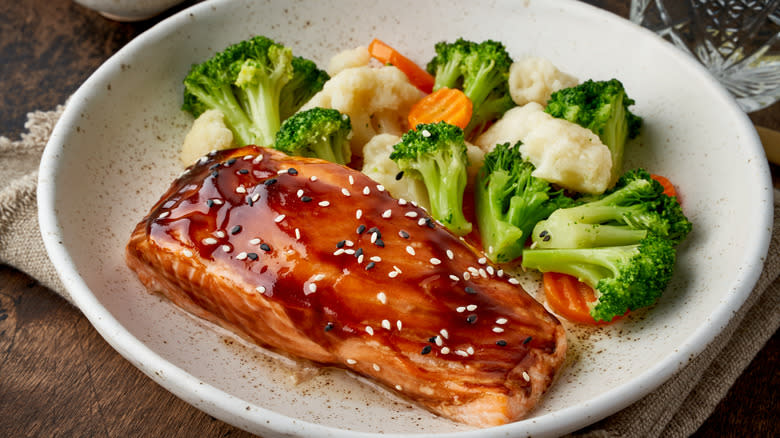
The greatest advantage teriyaki has over other similar sauces is its incredible versatility. This is a sauce that makes a good match for all proteins. It pairs well with most veggies and naturally goes well with noodles and rice. Astonishingly, this is not because it's neutral and barely noticeable. Teriyaki is usually robust and evident but still blends in perfectly to create alluring dishes infused with an ideal patchwork of flavors.
That being said, chicken and salmon are arguably teriyaki's favorite partners. These are foolproof pairings where both ingredients amplify each other to achieve perfect harmony. Pork and beef are also suitable, especially when grilling or using a slow-cooked method. In the seafood department, teriyaki is best paired with meaty and fatty fish, as it may come off as too powerful when paired with tender, white-fleshed varieties and thin fillets. Yellowtail is the ideal choice and a popular option in Japanese cuisine.
Don't forget about tofu and veggies. Tofu is relatively neutral and benefits from heavy teriyaki flavors. You can pair many veggies with teriyaki, but some classic and reliable choices are mushrooms, carrots, peppers, broccoli, cabbage, and green beans.
The Sauce Has A Long Shelf Life
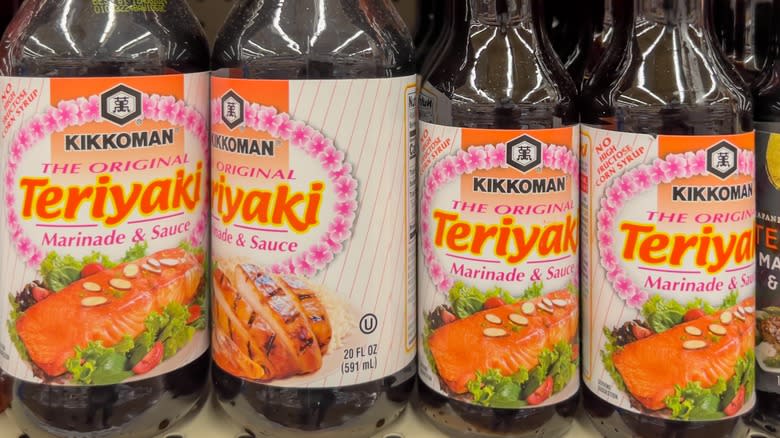
Another great asset that teriyaki boasts is a fairly long shelf life. Thanks to the composition of relatively stable ingredients, you can always have a bottle in stock without worrying that it will go bad quickly. In most cases, store-bought versions have additives and preservatives to prolong their shelf life, while homemade versions need to be rotated more often.
Once opened, store-bought teriyaki can last for a couple of months. You'll want to refrigerate it immediately after opening, while sealed bottles can be stored in the pantry and should be used within six to 12 months. After opening, teriyaki will slowly lose some of its intensity, which isn't something to worry about. But if you notice any change in smell or texture, you should throw it out immediately.
Homemade versions are less uniform, so it is rather difficult to provide an accurate expiry date. They will stay good for one week if refrigerated, but it's best to whip it up fresh and use the whole blend at once. This will ensure the flavors are always bright and spot-on. You can also freeze teriyaki if you are not planning to use it before the expiry date.
Read the original article on Mashed.

